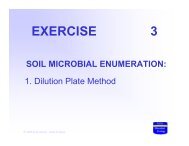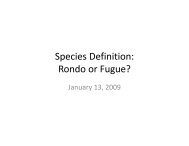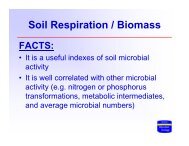Soil Microbial Ecology - Soil Molecular Ecology Laboratory
Soil Microbial Ecology - Soil Molecular Ecology Laboratory
Soil Microbial Ecology - Soil Molecular Ecology Laboratory
You also want an ePaper? Increase the reach of your titles
YUMPU automatically turns print PDFs into web optimized ePapers that Google loves.
Page 29<br />
METHOD<br />
1. Place a small drop of clear water on a clean microscope slide using the<br />
inoculating loop.<br />
2. Flame the inoculating loop, let it cool, and transfer a small portion of a bacterial<br />
colony to the drop of water.<br />
3. Using a circular motion, mix and spread the resulting cell suspension to cover an<br />
area about the size of a dime. Flame the loop again immediately.<br />
4. Allow this smear to air dry and then heat fixes it by passing it briefly through the<br />
flame of the burner several times. Add a few drops of methylene blue to cover the<br />
smear. Use sparingly to avoid making a mess with spillage.<br />
5. After the dye has been on the smear for 4 min, gently rinse it in a stream of water<br />
in the sink.<br />
6. Blot the slide dry using a pad of bibulous paper. Examine the stained smear at the<br />
different magnifications on the microscope. Be sure to use the oil immersion<br />
objective to view the preparation.<br />
PREPARATION OF WET MOUNTS:<br />
It is not always desirable to view only stained preparations of bacteria since no<br />
information is gained as to whether or not the organisms are motile i.e. if they have<br />
flagella (the organelle of locomotion in bacteria: singular = flagellum). To determine<br />
whether an organism is motile, it is usually observed in a wet mount.<br />
METHOD<br />
Place a small drop of water on a microscope slide using a flamed inoculating loop.<br />
Flame the loop, let it cool and add some bacterial from a culture to the drop of water.<br />
Mix but do not spread the drop out. Alternatively, if you have a broth culture, simply<br />
place several loop-full onto the center of the slide to form a drop.<br />
After you have placed the cell suspension on the slide, simply place a cover slip over the<br />
drop to obtain as few air bubbles as possible. This is most easily done by bringing one<br />
edge of the cover slip into contact with the edge of the drop and then laying the cover slip<br />
down on an angle so the fluid flows evenly across the slide.<br />
GRAM STAIN FOR BACTERIA<br />
There are basically two types of bacteria, gram + (purple color) and gram - (no purple<br />
color) when stained with Crystal Violet and Iodine. This is mainly due to the chemical





